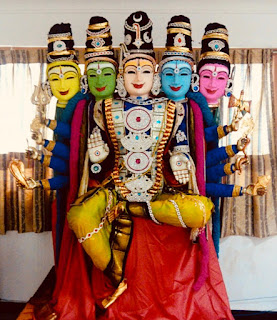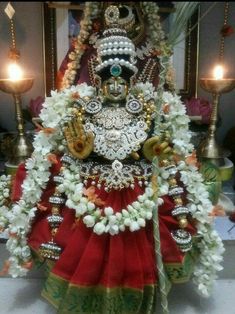षडङ्ग-देवातायुक्ता (386)
ṣaḍaṅga-devādāyuktā
ṣaḍ (six) + aṅga (parts) means six parts. For every mantra there are six parts and each such part is under the control of a god/goddess called aṅaga devatā-s of the presiding deity. These six parts are heart, head, tuft of hair, arms, eyes and weapons. Before and after the recitation of a mantra, the deities of these parts are worshipped in our bodies by touching the respective body parts with fingers. This is with regard to the external worship.
This nāma says that She is surrounded by these six aṅaga devatā-s.
षाङ्गुण्य-परिपूरिता (387)
ṣāḍguṇya-paripūritā
She is endowed with six qualities that are considered auspicious. They are prosperity, righteousness, fame, material wealth, wisdom and dispassion. Dispassion because, She will not show any special favours to a select few, transcending the law of karma.
नित्य-क्लिन्ना (388)
Nitya-klinnā
Her ever compassionate nature is referred here. Nitya-klinnā is the name of a tithi nityā devi (third day of the lunar fortnight).
निरुपमा (389)
Nirupamā
She is without comparison.
निर्वाण-सुख-दायिनी (390)
Nirvāṇa-sukha-dāyinī
Nir (freed) + vāṇa (derived from bāṇa, meaning body). When mind is freed from body, it leads to bliss. When higher level of consciousness is reached, physical body is forgotten. When bodily afflictions are dissolved, what is derived is eternal bliss. She confers this bliss to those who worship Her.
नित्या-षोडशिका-रूपा (391)
Nityā-ṣoḍaśikā-rūpā
This refers to the sixteen deities representing sixteen lunar days and they are worshipped in Śrī Cakra. The sixteenth deity is Lalitāmbikā Herself. These fifteen deities are said to represent fifteen bīja-s of Pañcadaśī mantra and Lalitāmbikā as the sixteenth deity representing ṣodaśī mantra. ṣodaśī mantra has sixteen bīja-s, the additional bīja being श्रीं (śrīṁ), the Lakṣmī bīja. ṣodaśī mantra is considered as the most powerful mantra of all. This is the mantra meant only for the final liberation.
श्रीकण्ठार्ध-शरीरिणी (392)
Śrīkaṇṭhārdha-śarīriṇī
She has half the body of Śiva. Śrīkaṇṭha is another name of Śiva, since He holds poison in His throat. Śrī also means poison and kaṇṭha means throat.
प्रभावती (393)
Prabhāvatī
She is endowed with the power of effulgence. She is surrounded by eight devi-s each representing one of the aṣṭama siddhi-s. They are very powerful and illuminant and known as aṇimā, laghimā, mahimā, īśitva, vaśitva, prākāmya, prāpti and sarvakāma.
These eight devi-s are called prabha. Prabhāvatī is the One who is surrounded by prabha-s.
प्रभारूपा (394)
Prabhārūpā
She is said to be in the form of Supreme light.
प्रसिद्धा (395)
Prasiddhā
She is highly celebrated. She is in the form of inner Self of all living beings.
परमेश्वरी (396)
Parameśvarī
She is the supreme ruler.
मूलप्रकृतिः (397)
Mūlaprakṛtiḥ
Prakṛti is the root of all creations. This is also known as the Brahman with attributes or saguṇa Brahman. Śaktī is called mūlaprakṛtiḥ because She is the part of Brahman without which creation is never possible.
अव्यक्ता (398)
Avyaktā
Avyakta is the state of prakṛti in its un-manifested form, the first stage of the Brahman that cannot be explained, as this is the purest form, without parentage. This stage is also known as turya or the fourth state of consciousness. It is the non-dualistic state, where the Brahman without a second is realized.
व्यक्ताव्यक्त-स्वरूपिणी (399)
Vyaktāvyakta-svarūpiṇī
It is vyakta (manifested) + avyakta (un-manifested) svarūpiṇī. She is both in the manifested and un-manifested form. Vyakta means perishable and a-vyakta means imperishable. The soul-Brahman relationship is cited here. This nāma means the first signs of creation and final liberation are both caused by Lalitāmbikā.
व्यापिनी (400)
Vyāpinī
She is all pervading. Because She is mūlaprakṛtiḥ and avykatā, She is all pervading.
विविधाकारा (401)
Vividhākārā
She has many forms.
She is the Supreme Mother or Brahma rūpa. As the sustainer, She is Viṣṇu rūpinī .
As the destroyer, She is Rudra rūpā. As a witness to the total dissolution, She is mahā pralaya sākṣiṇī.
विद्याsविद्या स्वरूपिणी (402)
Vidyāvidyā svarūpinī
She is the form of knowledge and ignorance. Vidyā is not just knowledge.
It is the supreme knowledge leading to self-realization. Avidyā is the opposite of vidyā. In the stage of avidyā, one continues to be associated with performing rituals like fire rituals, external worship etc. Only when avidyā dissolves into vidyā, the final liberation is attained.
महा-कामेश-नयन-कुमुदाह्लाद-कौमुदी (403)
Mahā-kāmeśa-nayana-kumudahlāda-kaumudī
Mahā-kāmeśa is Śiva, nayana – eyes, kaumuda – the moon which shines bright during the second half of November and first half of December (the month of Kārttika), kumuda – lotus flower.
On seeing Lalitāmbikā, Śiva’s eyes become wide open like lotus flower blossoming when the moon shines.
भक्त-हार्द-तमो-भेद-भानुमद्-भानु-सन्ततिः (404)
Bhakta-hārda-tamo-bheda-bhānumad-bhānu-santatiḥ
She dispels the darkness of ignorance of Her devotees. This is compared to the sun dispelling the darkness when it rises.


























